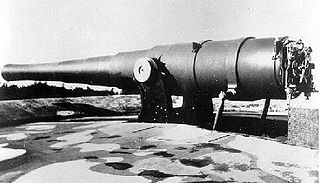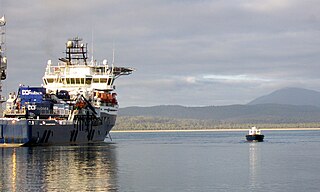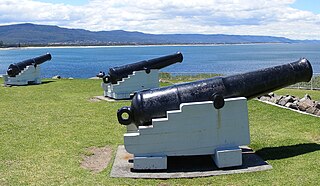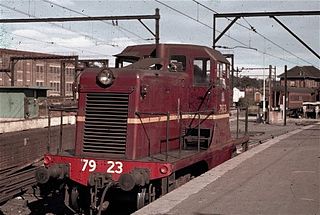
Portland Harbour is located beside the Isle of Portland, Dorset, on the south coast of England. Construction of the harbour began in 1849; when completed in 1872, its 520-hectare (1,300-acre) surface area made it the largest human-made harbour in the world, and it remains one of the largest in the world today. It is naturally sheltered by Portland to the south, Chesil Beach to the west and mainland Dorset to the north. It consists of four breakwaters: two southern and two northern. These have a total length of 4.57 km (2.84 mi) and enclose approximately 1,000 ha of water.

Port Kembla is a suburb of Wollongong 10 km south of the CBD and part of the Illawarra region of New South Wales. The suburb comprises a seaport, industrial complex, a small harbour foreshore nature reserve, and a small commercial sector. It is situated on the tip of Red Point: its first European sighting was by Captain James Cook in 1770. The name "Kembla" is an Aboriginal word meaning "plenty [of] wild fowl".

Cringila railway station is located in Cringila, Australia, on the South Coast railway line's Port Kembla branch. The station serves NSW TrainLink trains travelling south to Port Kembla and north to Wollongong and Sydney.

Wollongong Breakwater Lighthouse, also known as Wollongong Harbour Lighthouse, is a historic lighthouse situated on the southern breakwater of the heritage-listed Wollongong Harbour, in Wollongong, New South Wales in Australia. Wollongong is the only place in the east of Australia to have two lighthouses located in close proximity of each other, the other being Wollongong Head Lighthouse. While no longer used, the lighthouse was restored in 2002 as operational and is listed an official local heritage building.

The Ben Buckler Gun Battery is a heritage-listed fortified former gun emplacement and military installation of the late-Victorian period and now public open space located in the North Bondi locality of Ben Buckler, in the Sydney, Australia. The gun battery was designed by NSW Colonial Government and built during 1893. It is also known as Ben Buckler Gun Battery 1893, 9.2 Disappearing Gun and Bondi Battery. The property is owned by Waverley Municipal Council. It was added to the New South Wales State Heritage Register on 15 December 2006.

The Port of Eden is a small seaport situated in Twofold Bay, adjacent to the town of Eden, located in the South Coast region of New South Wales, Australia.

Flagstaff Hill Fort is a former military fort at Flagstaff Point, Wollongong, New South Wales, Australia.
Illowra Battery is a former Australian Army coastal-artillery battery located at Hill 60, Port Kembla, New South Wales in Australia, built and in service during World War II. It was also otherwise known as Hill 60 Battery.

Drummond Battery, also known as Fort Drummond, is a heritage-listed former coastal artillery fortification and now television station and mushroom farm at 1 Television Avenue, Mt Drummond, Mount Saint Thomas, City of Wollongong, New South Wales, Australia. It was built between 1942 and 1943 by the NSW Public Works Department and NSW Department of Main Roads. The Australian Army used the site from 1942.

The following is a List of Coastal Batteries in Australia and Territories during World War II. The main threat came early in the war from German raiders and threat of Japanese raids or invasion, and hence all available ordnance was pressed into service, including some obsolete guns and field guns adapted for coast defence.
Edward Giles Stone was an Australian engineer prominent in many innovative, often daringly spectacular, aspects of early reinforced concrete constructions in Australia. He was also involved in cement manufacture. He was briefly a pioneer in prefab housing but that industry was destined to use timber, not concrete plates.

The 79 class is a diesel-electric locomotive built by General Electric, Erie, United States for the Department of Railways New South Wales in 1943.

Adele was a steel screw steamer that was built in 1906 as a yacht. She was twice commissioned into the Royal Australian Navy (RAN), firstly as HMAS Franklin and later as HMAS Adele. She was wrecked at Port Kembla, New South Wales on 7 May 1943.

The 14th Brigade was an infantry brigade of the Australian Army. Originally raised in 1912 as a Militia formation, it was later re-raised in 1916 as part of the First Australian Imperial Force for service during World War I, the brigade was assigned to the 5th Division and served on the Western Front between 1916 and 1918 before being disbanded. It was later re-raised as part of the Australia's part-time military forces during the inter-war years. During World War II, the brigade was a Militia formation and it took part briefly in the New Guinea campaign with elements of the brigade undertaking defensive duties around Port Moresby before taking part in the fighting along the Kokoda Track and around the Japanese beachheads at Buna–Gona. The brigade was disbanded in mid-1943 as part of a rationalisation of Australian military forces as a result of manpower shortages.

HMAS Koolonga was a 4,260 gross register tons cargo ship built by Sunderland Shipbuilding Company, South Dock Sunderland, England, in 1914 and bought by McIlwraith, McEacharn Line Pty Ltd, Melbourne and named SS Koolonga. She was requisitioned by the Royal Australian Navy on 6 August 1914, as a collier and supply ship. She was returned to her owners in late 1915. She was sold in 1937 to Madrigal & Company, Philippines and renamed Paz. She was sunk during the Second World War at Manila Bay in December 1941 and was later salvaged by the Imperial Japanese and renamed Hatsu Maru. While at anchor in Manila Bay, Philippines on 13 November 1944, she was attacked by United States Navy carrier aircraft and was sunk.
Mount Saint Thomas is a suburb of Wollongong in New South Wales, lying east of Figtree and South west of Wollongong. At the 2021 census, it had a population of 1,449.

Port Kembla is a man-made cargo port or artificial harbour, with an outer harbour protected by breakwaters and an inner harbour constructed by dredging, located in the Illawarra region of New South Wales, Australia.
The Tomaree Head Fortifications is a heritage-listed fortification at 2 Shoal Bay Road, Shoal Bay, New South Wales, Australia. It is also known as Tomaree Head Battery, Tomaree Battery and Stephens Battery. It was added to the New South Wales State Heritage Register on 22 October 2010.

Wollongong Harbour Precinct is a heritage-listed shipping harbour at Cliff Road and Endeavour Drive, in Wollongong, New South Wales, Australia. It was built in 1837. The historic precinct includes Belmore Basin, Government Dam, Government Basin, Stockade Point, Flagstaff Hill, Signal Hill, Brighton Beach, Boat Harbour and Fortress Hill. It was added to the New South Wales State Heritage Register on 5 May 2010.

The Lithgow Heavy Anti Aircraft Gun Stations and Dummy Station is a heritage-listed former gun emplacements, anti aircraft gun batteries and dummy batteries and now disused railway signal box located via Kirkley Street, Bowenfels, City of Lithgow, New South Wales, Australia. It was built from 1941 to 1942 by Water Conservation & Irrigation Commission, Defence. It is also known as Lithgow Anti Aircraft Gun Emplacements and Heavy Anti Aircraft guns 3.7 inch anti aircraft guns. The property is owned by Lithgow City Council. It was added to the New South Wales State Heritage Register on 5 August 2011.

















